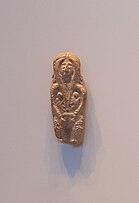Shalim
| Shalim | |
|---|---|
God of dusk | |
| Planet | Venus |
| Genealogy | |
| Parents | El (father) Asherah (mother) |
| Siblings | Shahar |
| Deities of the ancient Near East |
|---|
| Religions of the ancient Near East |
Shalim (Šalām, Shalem, Ugaritic: 𐎌𐎍𐎎, romanized: ŠLM) is a pagan god in Canaanite religion, mentioned in inscriptions found in Ugarit (now Ras Shamra, Syria).[1][2] William F. Albright identified Shalim as the god of the dusk and Shahar as the god of the dawn.[3] In the Dictionary of Deities and Demons in the Bible, Venus is represented by Shalim as the Evening Star and Shahar as the Morning Star.[1] His name derives from the triconsonantal Semitic root Š-L-M ("whole, safe, sound, peace").
Ugaritic inscriptions
[edit]An Ugaritic myth known as The Gracious and Most Beautiful Gods describes Shalim and his brother Shahar as offspring of El through two women he meets at the seashore. They are both nursed by "The Lady", likely Asherah, and have appetites as large as "(one) lip to the earth and (one) lip to the heaven." In other Ugaritic texts, the two are associated with the sun goddess.[1]
Another inscription is a sentence repeated three times in a para-mythological text, "Let me invoke the gracious gods, the voracious gods of ym." Ym in most Semitic languages means "day," and Shalim and Shahar, twin deities of the dusk and dawn, were conceived of as its beginning and end.[4]
Shalim is also mentioned separately in the Ugaritic god lists and forms of his name also appear in personal names, perhaps as a divine name or epithet.[1]
Many scholars believe that the name of Shalim is preserved in the name of the city Jerusalem.[5][1][6][7][8] The god Shalim may have been associated with dusk and the evening star in the etymological senses of a "completion" of the day, "sunset" and "peace".[9]
See also
[edit]References
[edit]- ^ a b c d e van der Toorn et al., 1999, pp. 755-6
- ^ Golan, 2003, p. 82. "The name of the Canaanite deity of the setting sun Salim, or Salem, [...] The names [of Sahar and Salim] are rendered in modern scholarly texts as Shakhar and Shalim [...]"
- ^ Albright, W.F. (1994). Yahweh and the Gods of Canaan: A Historical Analysis of Two Contrasting Faiths. G - Reference, Information and Interdisciplinary Subjects Series. Pennsylvania State University Press. p. 187. ISBN 978-0-931464-01-0.; cf. the Akkadian word for sunset, šalām šamši.
- ^ van der Toorn et al., 1999, p. 222.
- ^ Jenny Kien (2000). Reinstating the Divine Woman in Judaism. Universal-Publishers. pp. 65–. ISBN 978-1-58112-763-8. Retrieved 27 October 2020.
Royal names with the s-l-m root, such as Solomon and Abshalom, suggest that Shalim was still worshipped in the 10th century BCE, and that the early house of David participated in this cult.
- ^ N. Na'aman, Canaanite Jerusalem and its central hill country neighbours in the second millennium B.C.E., Ugarit-Forschungen Vol. 24 (1992), pp275-291.
- ^ L. Grabbe, Ethnic groups in Jerusalem, in Jerusalem in Ancient History and Tradition (Clark International, 2003) pp145-163.
- ^ John Day, Yahweh and the gods and goddesses of Canaan, Sheffield Academic Press 2002, p180
- ^ Helmer Ringgren; Heinz-Josef Fabry (2006). Theological Dictionary of the Old Testament. Wm. B. Eerdmans Publishing. pp. 24–. ISBN 978-0-8028-2339-7. Retrieved 19 June 2015.
Bibliography
[edit]- Albright, William Foxwell (1990) [1968]. Yahweh and the gods of Canaan: a historical analysis of two contrasting faiths (Reprint ed.). Eisenbrauns. ISBN 978-0-931464-01-0.
- Golan, Ariel (2003). Prehistoric religion: mythology, symbolism. Ariel Golan (Original from the University of Virginia. ISBN 978-965-90555-0-0.
- van der Toorn, Karel; Becking, Bob; van der Horst, Pieter Willem (1999). Dictionary of Deities and Demons in the Bible DDD (2nd, revised ed.). Wm. B. Eerdmans Publishing. ISBN 9780802824912.


